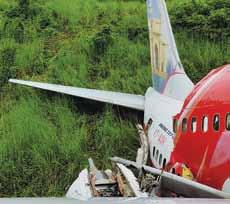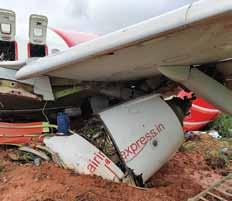
8 minute read
Flight Safety
AIR INDIA EXPRESS STRUCK WITH AN UNMITIGATED DISASTER
The airport at Calicut was upgraded to international status in 2006 and today it is the 11th busiest airport in the country in terms of traffic
By Air M
rsh l B.K. P ndey (Retd)
( Left to right ) : minister of civil aviation hardeep s. puri inspecting the crash site; the pl ane fell in a gorge 35 feet deep and broke into two; the broken fusel age and the scattered debris of the pl ane.


On Friday August 07 this year, Air India Express Flight
IX 1344, a Boeing 737 airliner with 190 persons on board that was on a Vande Bharat Mission sponsored by the government to bring back Indian citizens stranded abroad, took off from Dubai for Calicut International Airport, Kozhikode in Kerala, ended up in a disaster at 1941 hours when trying to land at the destination airport. The airliner overshot the runway and fell into a gorge 35 feet deep on account of which, the fuselage broke into two pieces. The captain of the aircraft Deepak Vasant Sathe, the co-pilot Akhilesh Kumar, four members of the cabin crew and 14 passengers perished in the accident. Apart from these fatalities, over 100 passengers were seriously injured. The fact that the wreckage did not catch fire was indeed fortunate as if it had, possibly none would have survived the accident. This was the worst disaster that Air India Express has suffered since the loss of a Boeing 737 aircraft that overshot the runway while landing on the table top runway at Mangaluru airport and fell into a deep gorge killing all 158 on board. The difference was that the accident in 2010 was in the day time and in good weather whereas in the accident at Calicut, the landing was attempted at night time and in extremely adverse weather conditions.
Calicut International Airport, also known as Karipur Airport, is located in Karipur which is in Malappuram district of Kerala. The airport serves South Malabar region of Kozhikode, Malappuram, Palakkad and Wayanad.
WHAT LED TO THE ACCIDENT?
The Black Box which contains the Digital Flight Data Recorder (DFDR) and the Cockpit Voice Recorder (CVR), has been recovered from the wreckage and only after the data is retrieved and analysed by the Aircraft Accident Investigation Bureau under the Ministry of Civil Aviation, can the precise cause of the accident be established. As this will take time, here is an attempt in the interim to study and analyse the factors available in the public domain that could have led to the disaster.
LANDING IN ADVERSE WEATHER CONDITIONS
First and foremost is the prevailing weather conditions. With an active monsoon this year especially over Kerala, there was heavy rain accompanied by strong and gusty wind conditions in and around Calicut International Airport that has a table top runway 2,860 metres long. There are fairly deep gorges on both ends of the runway as also in some areas along the side of the runway. The orientation of the runway is 280 degrees/100 degrees, nearly East-West. As a landing is normally required to be carried out into wind to achieve a touch down at lower ground speed, given the prevailing wind conditions at that
time, the first approach for landing was made by the pilot for TABLE TOP RUNWAY runway 28 or the Westerly runway that offered the advanThere are several table top runways across the world includtages of strong head wind. However, for some reason which ing three in India. For operating from table top runways, will be ascertained from the CVR, the pilot was unable to exeappropriate training for skill development and formal clearcute a landing and carried out a missed approach procedure. ance is required for each runway as these have inherent charThereafter, the pilot in command decided to make a second acteristics and hazards that are not common to all. Operation attempt at landing, but this time from the opposite direction from table top runways can also be very challenging as these i.e. Easterly, for runway 10. However, in this attempt, the pilot offer very little margin for error. Prior to the crash on August made an approach for landing with strong tail wind condi07, the Calicut airport had recorded four accidents. On August tions, reported to be around 15 knots, resulting in an over04, 2017, a SpiceJet flight had skidded on landing and damshooting approach and at significantly higher ground speed aged the ILS beacons. The same year on April 25, an Air India at the time of touchdown. The second attempt at landing was flight suffered an engine failure during takeoff leading to a left also abortive. In the third attempt on runway 10, on account tyre burst. On July 09, 2012, an Air India Express skidded on of the strong tail wind, the float period got extended and the landing, again during heavy rain. On November 07, 2008, Air pilot in command managed to make the aircraft touch down India flight from Jeddah had scraped the runway with its right at about 1,000 metres from the beginning of the runway. This wingtip while landing. left the pilot with just 1,860 metres in which he had to bring In the case of Calicut airport, the height of the table top the aircraft to a halt. runway is only 35 metres. Another limitation of this table top
On account of the heavy rain, the runway was waterlogged. runway is that the Runway End Safety Area (RESA) which While landing under these conditions, the “Braking Coefcaters for overruns, is less than then the prescribed figure, ficient” is reduced significantly the aircraft is likely to expecausing a potential safety hazard. There was talk of extendrience “Aquaplaning”, a phenomenon that is also known as ing the runway to 3,000 metres and the RESA to the required “Hydroplaning”. When this happens, length, but as the runway is located on the braking system of the aircraft top of a hill, it would involve enormous becomes less effective with the Brakeffort and investment to create extra ing Coefficient even reducing to zero. Contact of the wheels with the runway surface reduces drastically resulting in Following the accident at land at that height at both ends of the runway. The airport at Calicut was upgraded locking of the wheels when the brakes Mangaluru airport to international status in 2006 and are applied. As a result of this, the aircraft begins to skid with the pilot in 2010, a number today it is the 11th busiest airport in the country in terms of traffic. Followbeing unable to control further moveof improvements ing the accident at Mangaluru airport ment of the aircraft in respect of speed and direction. Under these conditions, brakes become totally ineffective and were suggested, but these are yet to be in 2010, a number of improvements were suggested, but these are yet to be implemented. There is a standard operincapable of reducing the ground implemented ating procedure (SOP) laid down by the speed of the aircraft. Directorate General of Civil Aviation for
Thus after a touchdown at 1,000 removing water from the runway. As to meters from the beginning of the runwhether or not this SOP was followed way 10 and at significantly higher at Calicut International Airport in this ground speed, the pilot in command was not able to stop the case, will be known after the investigations are over. aircraft in the remaining length of the runway and fell into a gorge 35 feet deep after uncontrolled skidding past the end of PROFESSIONAL CREDENTIALS OF THE PILOTS IN COMMAND the runway. It appears that having lost control of the aircraft Captain Deepak Vasant Sathe, the captain of the ill fated Air on the landing run, the pilot foresaw what was coming and India Express flight, had joined the National Defence Academy possibly shut down both the engines thus obviating the posas an Air Force Cadet and was commissioned into the Indian sibility of the wreckage catching fire. The low rate of fatalities Air Force (IAF) as a fighter pilot in June 1981. He served with in an accident of this kind, can possibly be attributed to this No. 17 Golden Arrows Squadron that is now being reequipped action by the pilot. But what is more intriguing is why the pilot with Rafale jets. Deepak Sathe was also trained as a Test Pilot could not manage a successful approach and landing on runin the IAF. While serving as a fighter pilot, he was involved in way 28 where he would have had head wind conditions. What flying accident in the early 1990s in which he suffered serious also needs an answer is as to why the pilot chose to make head injury. However, due to his strong will power and passion an approach for landing on runway 10 where he encountered for flying, he successfully returned to military flying. He took strong tail wind conditions. And more importantly, as per the premature retirement in the rank of Wing Commander after company policy, the pilot was required to divert to another 21 years of service and migrated to civil aviation. He joined Air airport with less severe weather conditions; but he did not India in 2013. Captain Sathe was undoubtedly endowed with choose to do so. There were a number diversionary airfields outstanding professional credentials. with less severe weather conditions available for the pilot to Akhilesh Kumar, the co-pilot of the ill fated Air India choose from such as Kannur, Cochin, Trivandrum, Mangaluru Express flight, began flying with Air India in 2017 and was the or even Bengaluru. Answers to the question as to why the pilot first officer of the Air India Express flight in May, which was did not opt to divert will be found in the CVR which will also the first repatriation flight under the Vande Bharat Mission to reveal the communication between the aircraft and the Air land in Kozhikode, bringing back stranded Indians in Dubai. Traffic Controller on duty. He had a total flying experience of 1,723 hours. SP










